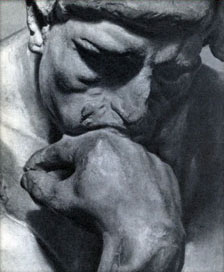the study of the logic of the operators ‘it is possible that’ and ‘it is necessary that’. These operators are usually symbolized by B and A respectively, and each can be defined in terms of the other. To say that a proposition is possible, or possibly true, is to say that it is not necessarily false. Thus B f could be regarded as an abbreviation of -A-f. Equally, to say that a proposition is necessary, or necessarily true, is to deny that its negation is possible. Thus Af could be regarded as an abbreviation of -B-f. However, it aids comprehension to take both operators as primitive. Systems of sentential modal logic are obtained by adding B and A to sentential logic; if the sentential logic is classical/intuitionist/minimal, so is the corresponding modal logic. We concentrate on the classical case here. As with any kind of logic, there are three components to a system of modal logic: a syntax, which determines the formal language + and the notion of well-formed formula (wff); a semantics, which determines the semantic consequence relation X on +-wffs; and a system of inference, which determines the deductive consequence relation Y on +-wffs. The syntax of the modal operators is the same in every system: briefly, the modal operators are one-place connectives like negation. There are many different systems of modal logic, some of which can be generated by different ways of setting up the semantics. Each of the familiar ways of doing this can be associated with a sound and complete system of inference. Alternatively, a system of inference can be laid down first and we can search for a semantics for it relative to which it is sound and complete. Here we give primacy to the semantic viewpoint.
Semantic consequence is defined in modal logic in the usual classical way: a set of sentences 9 semantically entails a sentence s, 9 X s, if and only if no interpretation I makes all members of 9 true and s false. The question is how to extend the notion of interpretation from sentential logic to accommodate the modal operators. In classical sentential logic, an interpretation is an assignment to each sentence letter of exactly one of the two truth-values = and <, and the truth-value of a sentence in an interpretation is calculated by applying the truth-functions expressed, according to the semantics, by the connectives, to the sentence letters of the sentence. But we cannot extend this to modal logic by assigning some further truth-functions to the modal operators, since neither of these operators expresses a truth-function. For example, given just that f is true, we cannot determine the truth-value of Af, for if f is a contingent truth ('Hume is a famous philosopher') then Af is false, while if f is necessary ('All famous philosophers are philosophers') then Af is true.
The solution is to regard B and A as quantifiers over entities called possible worlds. A possible world is a complete way things might be or might have been; the actual world is a possible world and so is any other way things might have gone, e.g. one in which Hume was obscure. Af is then interpreted as saying that f is true in all possible worlds, while B f is interpreted as saying that f is true at at least one possible world. A statement is true if it is true at the actual world (usually denoted ‘w*’), and given some supply of possible worlds, the truth-value of any statement f at the actual world can be calculated by applying these two rules for the modal operators (together with the truth-functions for the non-modal connectives). For example, A(BP B (C & D)) is true at w* if B P B (C & D) is true at every world w, which requires in turn that either B is false at w or else that at some world u, C and D are both true. Thus we can calculate the truth-value of A(B P B (C & D)) provided we know the truth-values of the sentence letters B, C, and D at each world. An interpretation should therefore contain a collection W of possible worlds (including one designated as w*) and a specification, for each world w, of the truth-values of all sentence letters at w; in other words, a collection W of worlds that associates each w in W with an interpretation of the non-modal part of the language. However, there is also a third component. A world v may be said to be possible relative to a world u if no proposition necessarily true at u is false at v. The idea here is to accommodate the thought that what is necessary or possible may depend on how things actually are; thus, given the way things actually are, certain things may be possible that would not be possible if things had actually been different. Suppose that I might have originated from a different sperm, or a different egg, but not both, and suppose that at the actual world I originate from s1 and e1, so that there is a possible world u where I originate from s1 and e2 and a possible world v where I originate from s2 and e1. Then both u and v are possible relative to the actual world, but if it is true at every world that one could not have originated from a different sperm and egg, then u and v are each impossible relative to the other. The third component of an interpretation is therefore a stipulation of which worlds are possible relative to which. The stipulation takes the form of the specification of a two-place relation R on W. A two-place relation on a set is a collection of pairs of objects from the set; e.g., the relation ‘immediately precedes’ on the natural numbers is the set of pairs
